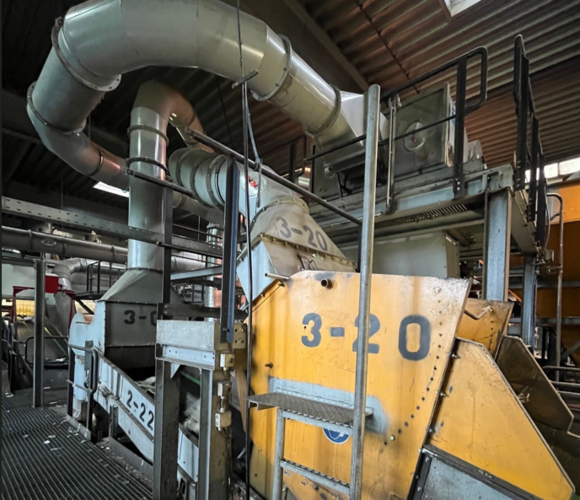What exactly is an air classifier? Explained by Arno Vogel
How does it work?
Most LWP sorting plants make use of vertical air classifiers, with a vertical stream of air separating materials according to their airflow resistance. Lightweight films and foils with a large surface area are blown upwards, while heavier pieces fall downwards. The principle is similar to that of a vacuum cleaner: light items like films, foils, and paper tissues are vacuumed up, while heavy objects like stones stay put. The air classifier has a nominal airflow of 20,000 m³/h. This number specifies the volume of air per hour that the air classifier can use to separate materials, under optimum operating conditions. Noise emissions are also comparable to those produced by vacuum cleaning.
Why is the machine so special?
The machine uses the age-old principle of ‘winnowing’, an ancient method used in agriculture to separate wheat from the chaff. Otherwise, the materials (here: films/foils) would need time-consuming sorting – possibly even by hand. The Berlin plant operated by Interzero Plastics Sorting uses several air classifiers with fans and rotary feeders, integrated into the plant’s automated systems. Operation, maintenance and servicing is all handled by specialist personnel. Depending on how dirty the sort material is, air classifiers may need more or less maintenance. Dirty material produces deposits that need to be removed regularly, while impurities also cause excessive wear. Depending on its size and performance, a new air classifier can run to several hundred thousand euros.
On 1 March this year, Arno Vogel joined our team in Berlin as our new Technical Manager and Deputy Plant Manager for the LWP sorting plant. A state-certified automation engineer, he sees himself as a troubleshooter who sees problems as opportunities. Away from the plant, Arno enjoys spending time with his family outdoors, and is a keen gardener and DIY enthusiast.



![[Translate to English - Englisch:] [Translate to English - Englisch:]](/fileadmin/_processed_/1/4/csm_230606-AGA-Tridi-Indonesia-PET-recycling_e3dcd2ad90.jpg)
![[Translate to English - Englisch:] [Translate to English - Englisch:]](/fileadmin/_processed_/d/e/csm_230302_AGA-VietCycle_800x533_4545226899.jpg)
![[Translate to English - Englisch:] TANDIL 3-in-1-Box made up of 92 per cent recycled material](/fileadmin/_processed_/3/8/csm_240209-Tandil-Award_cde01ee674.jpg)